Even today the purpose of megaliths – huge cult structures of antiquity, erected in all parts of the globe – remains a riddle for contemporary science. Such grandiose buildings still amaze researchers and ordinary people by the new facts indicating that millennia ago humanity was much more educated than we are in our age of “high” technology.
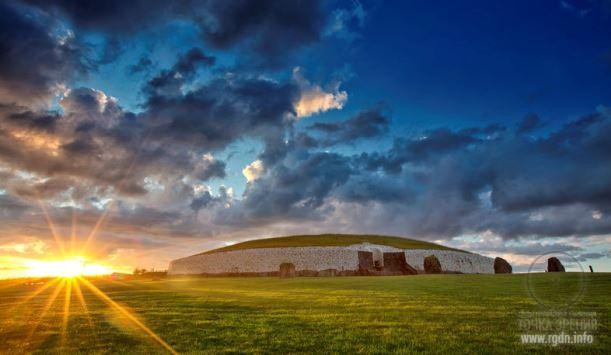
One of such megalithic structures is Newgrange – a mound situated in Ireland, approximately 40 kilometres away from the Irish capital city Dublin, in a picturesque place in the BoyneValley. Radiocarbon tests show the mound dates back to about 5,000 years ago. Hence, the structure is approximately one thousand years older than the famous Stonehenge and 500 years older than the Pyramids of Giza, Egypt. Just like many ancient monuments of the world, Newgrange was not erected by itself, but is a part of a mound complex called Brú na Bóinne. Knowth and Dowth mounds are located nearby and also very interesting. (Knowth, for instance, preserves a quarter of all known petroglyphs in Europe.) However, since Newgrange is the most famous of the mounds, in this article I will consider it in particular.
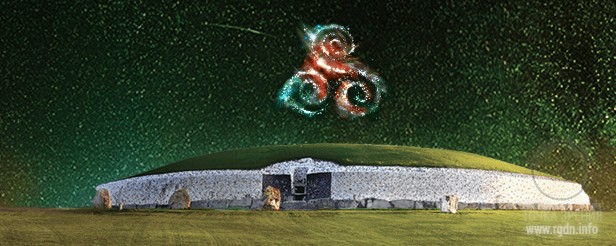
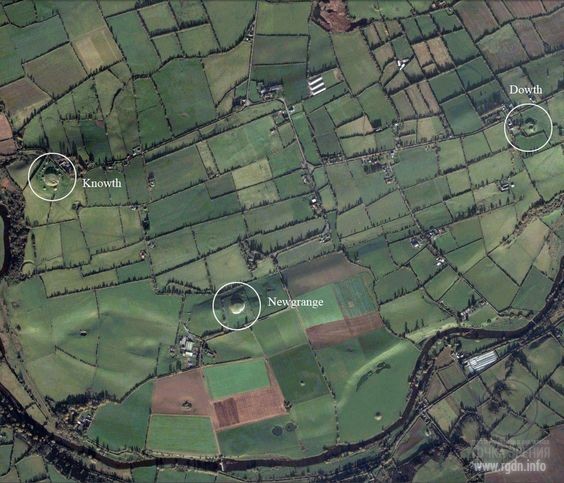
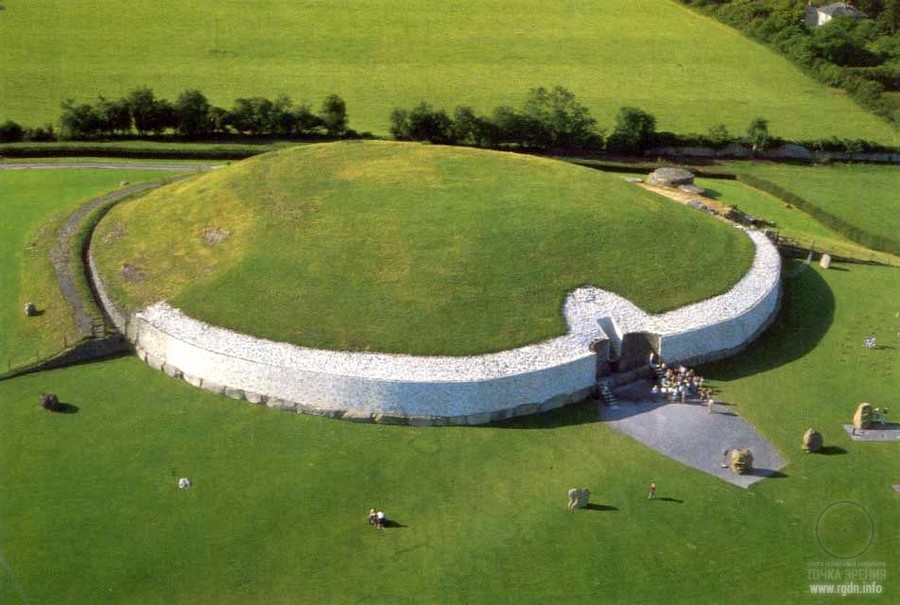
For many centuries this enigmatic building was hidden from people under a layer of soil, and nobody suspected the green hill could conceal such a creation. It was discovered by accident in 1699 by servants of the local count Charles Campbell, who were looking for construction stones. The workers immediately informed their master of the discovery, and he shared the news with Edward Lloyd, the Welsh fancier of antiquities and former curator of AshmoleanMuseum in Oxford. Lloyd began to study Newgrange and used the opportunity to ascribe the discovery to himself. Thanks to him, the megalith was nicknamed an ordinary tomb, and it was freely accessible for quite a long while until once the professor of archaeology Michael J. O’Kelly turned out to be among visitors of the ruins. O’Kelly immediately grasped it was necessary to study Newgrange and, perhaps, to restore it.
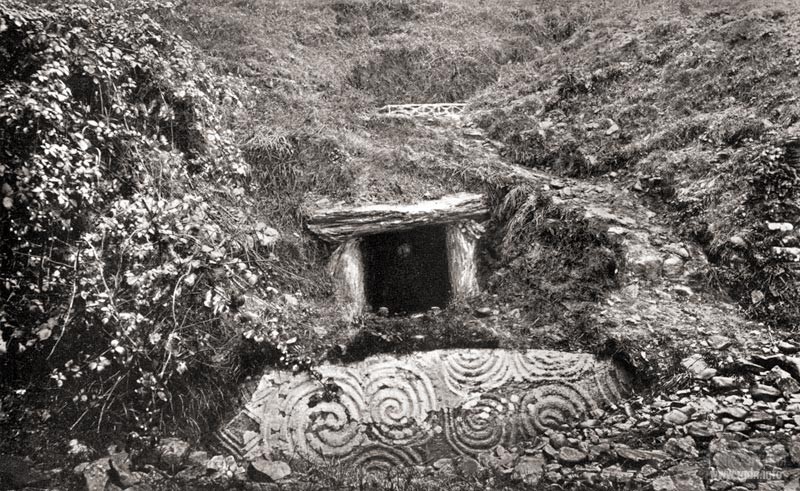
The height of Newgrange is about 13.5 m, its diameter is 95 m, and its perimeter is 298.45 m. It consists of 650 giant stone blocks (which were moved there from a rather distant area, in an unintelligible way).
The mound made of alternate layers of small stones and earth is surrounded with 97 big stones that are usually called kerbstones. Some of them are skilfully decorated with petroglyphs and faced with white quartz (the current white-quartz façade is the reconstruction by the expedition of O’Kelly).
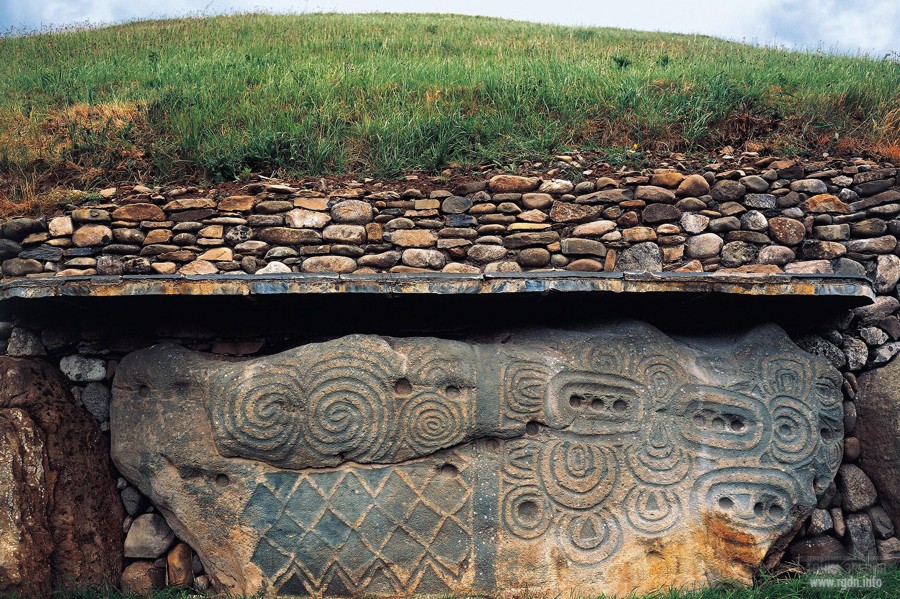
Around the Newgrange mound there are 12 stones, 8 feet in height.
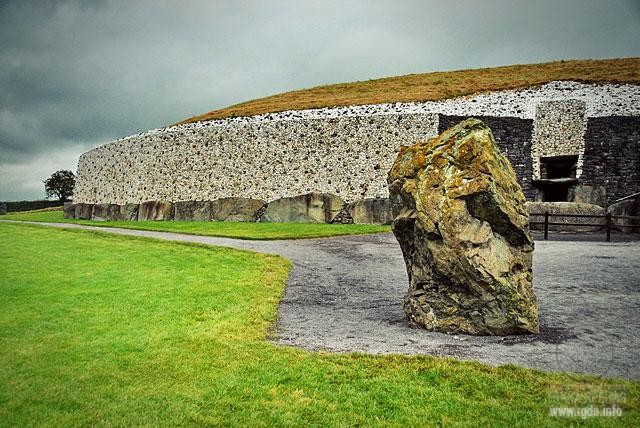
At the entrance, there is a huge plate resting against the wall, which after construction is usually used for blocking the way to an underground passage.
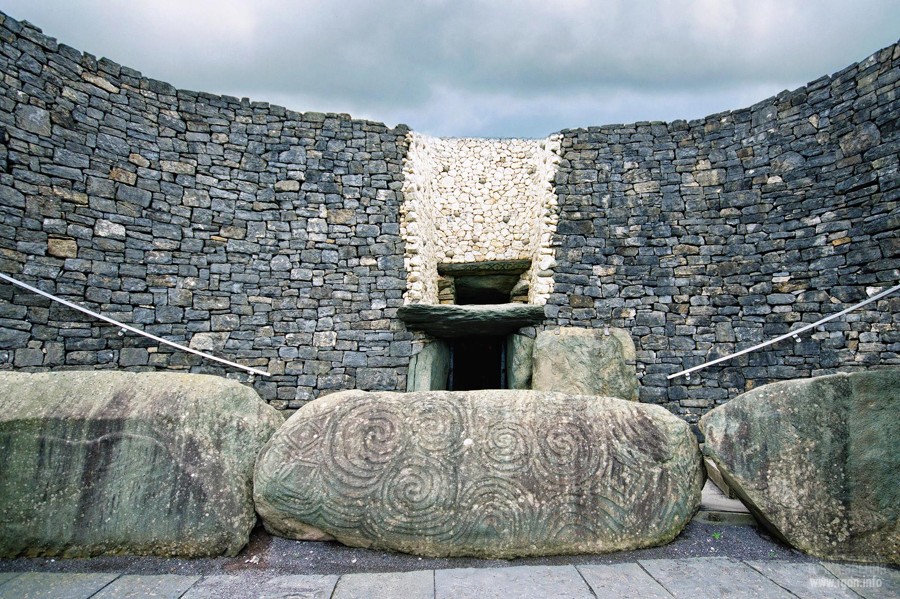
The underground passage, oriented to the southeast, occupies an area of 18 metres in length. It leads to a cruciform chamber the foundation of which is made of vertical stone monoliths of 20 to 40 tons each.
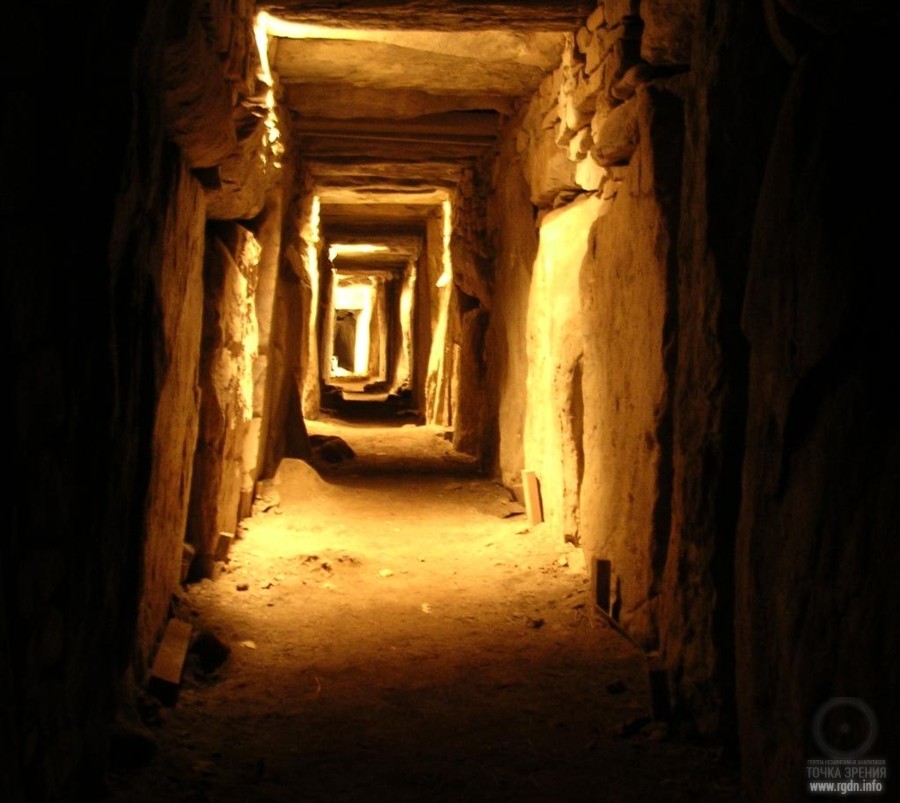
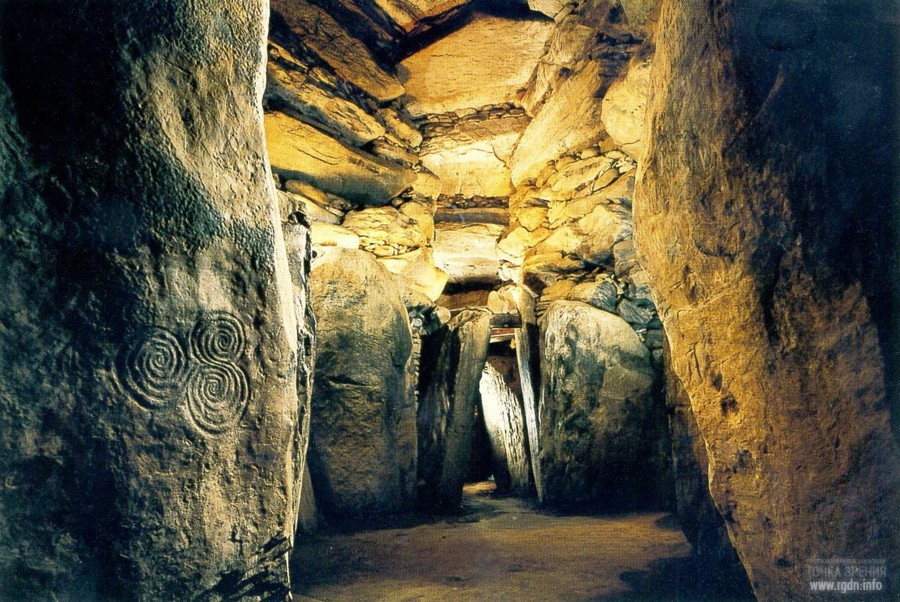
Newgrange: а – general layout; b – section; с – inner premises
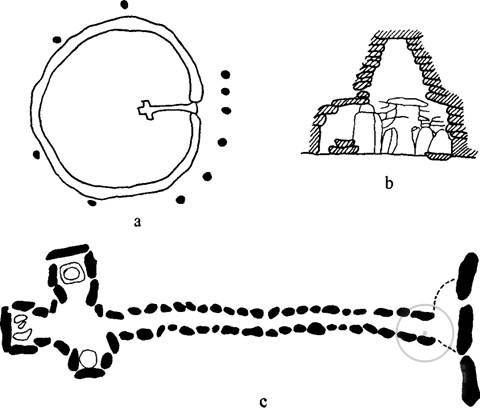
The megaliths form a hexagonal hollow cupola, narrowing upwards, of about 6 metres in height. The stones which form a stepped vault were selected in such a way that the heaviest stones are located underneath, whereas the upper stones are the lightest. Despite the seemingly unstable structure, researchers are amazed by the fact that over so many years the roof has neither decayed nor ever become leaky in spite of frequent rains typical for Ireland. Furthermore, the mound stones are joined with one another in an unintelligible way: ancient masters did not use any mortar, but simply adjusted the blocks so tightly that even a blade cannot fit between them.
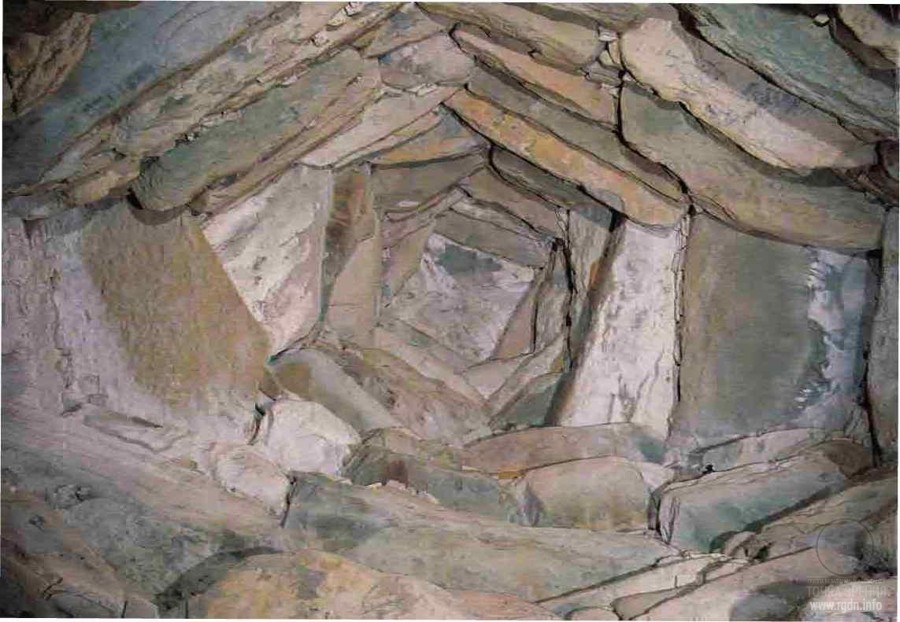
The chamber disposition itself is similar to the disposition of the Stonehenge ring, though at this site the roof is covered with earth. Inside the chamber, a stone ritual bowl has been preserved until today.
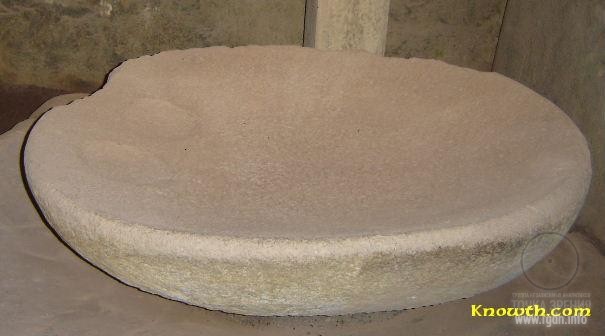
During his expedition O’Kelly found out that, according to one of legends, the Newgrange tomb concealed a secret that could be unravelled on one day in a year only.
The 21st of December 1967 was the day when archaeologists finally cleaned the entire passage through the building. Early in the morning O’Kelly came to Newgrange, entered the inner premises and stopped right in the middle of the dark passage. Intuition took him there.
The sun appeared at 08.58 a.m.
“To the surprise of Professor O’Kelly, the premise and the passage got lit up. Sunbeams stretched along the walls and illumined everything around. The entire premise, the walls, the floor, the six-metre ceiling were bathing in sunlight,” one of descriptions of the 1967 events says. O’Kelly was stiffen with astonishment, charmed with what he saw in Newgrange.
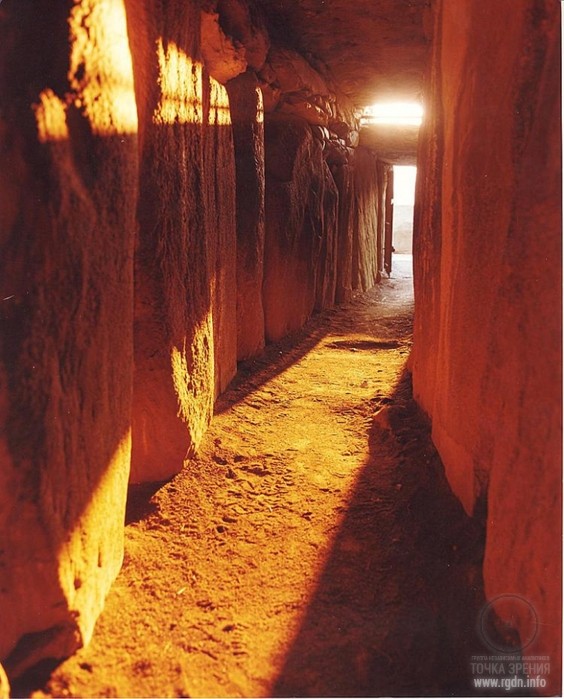
This is surely the most bewitching point that engrosses people’s attention to Newgrange: the building is designed in such a way that only one day in a year – at dawn onthe winter solstice (between 19 and 23 December) – the sun penetrates through a small window above the entrance (the window width is just 19 centimetres) and illumines the entire passage through. Exceptionally bright light falls into the cruciform chamber and literally floods the whole premise for about seventeen minutes, being reflected from the oval bowl.
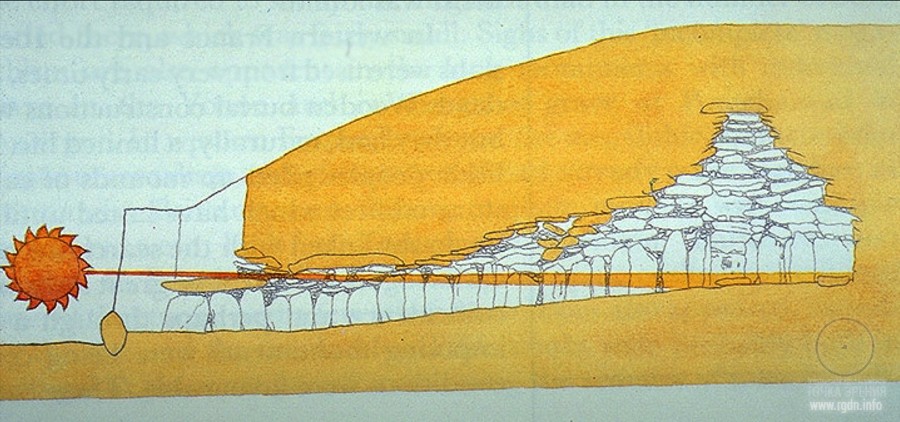
Some Irishmen say one who has touched this light becomes purer and obtains enormous power. Whether it is so or not, only those can tell who have visited the mortuary chamber on the winter solstice. Very few people manage to do so. Every year, only fifty lucky ones out of tens of thousands of those who desire get a chance to observe the unique sight, full of mysterious sacral meaning, and they are the winners of a special lottery.
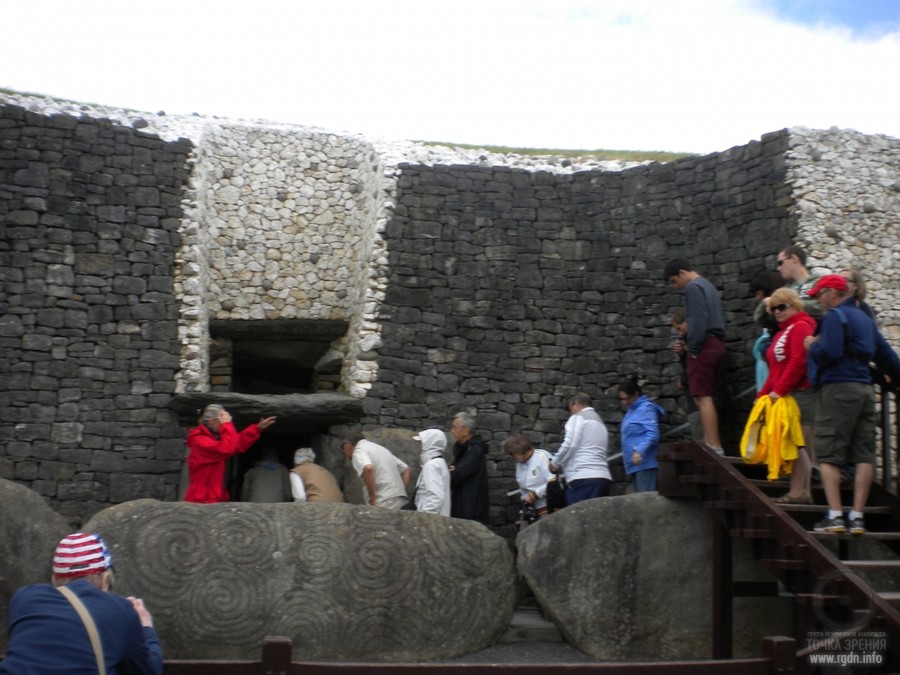
Researchers are still staggered by the level of knowledge of the Newgrange constructors, for official history claims in the late Stone Age “the awakening of human thought only started”. In such case it is totally unclear by means of which technology it was built and who the ancient astronomers were who managed to calculate the course of the sun with the utmost precision. Were those Celtic tribes that inhabited the island, or somebody before them? Not many people understand how difficult it is to design such a building. Even taking into account the significant alteration of the terrestrial axis inclination that has taken place since those times, the “light miracle” is invariably observed every year on the winter solstice. (By the way, in ancient times humanity revered the winter solstice very much almost throughout the planet. Nowadays its exact date differs from the date of Catholic Christmas by several days due to an error in calendar estimations, which was ascertained as long ago as in 325 AD.)
Let me cite an extract from an informative article by E. Vorontsova (Interesting Newspaper Plus, Issue No. 9 (120), 2003):
Professor of the National University of Ireland Dr. Mac Munn, having performed comparative analysis of Newgrange and the pyramids of Egypt, came to the conclusion that dimensions of the ancient stone colossi were based on identical parameters: the distance from the Earth to the Sun, the radius of our planet, and the number of days in a year. Moreover, in Ancient Egypt there existed such measurement unit as the “sacral cubit”, the length of which equalled to 52.36 cm. 570 “sacral cubits” precisely make 298.45 m.
Inside the monument, on the winter solstice the so-called “light miracle” may be observed. It is an inexpressibly beautiful play of light and shadow, which lasts for 17 minutes. Researchers have recently unravelled the secret of the “miracle”. The distance from the Earth to the Sun and backwards makes 298.45 million km (!) exactly. Light covers such distance within 17 minutes. It turns out the ancients were aware of the speed of light, and the time period of 17 minutes was chosen not by mere chance. Latest studies make it possible to assert the ancient constructors of Newgrange knew the pi number, the Solar System structure, the period of Moon rotation around the Earth, the distance between the Earth and the Sun, the speed of light, and many other things.
While Stonehenge is a model of our Solar System, Newgrange also represents a sort of a planetary system unknown to modern science. At that, scientists have managed to determine the system consists of 13 planets, and the system centre is a star similar to our Sun, located three light years away from us. Researchers assume Newgrange preserves many more secrets that are still to be uncovered.
Another peculiarity of Newgrange, just like of all ancient megaliths, is its extraordinary seismic stability. Earth tremors get softened or totally damped owing to special platforms. Furthermore, such foundations almost eliminate “earth shrinkage” that inevitably takes place upon modern construction.
As I have mentioned above, many plates outside and inside the mound are decorated with fretwork. In the ornament there are recurrent concentric circles, rhombuses in staggered rows, wavy and zigzag lines. Here is what the Primordial Knowledge tells about such pictures.
The AllatRa book, pages 622-623, 349, 374 – allatra.us:
Rigden: The rhombus shape is often found in the most ancient ornaments. It was called the symbol of unity between Earth and Heaven and was associated with a lily, a lotus.
Anastasia: Here, even if we trace the etymology of the word “rhombus”, we can elicit interesting facts. This word is derived from the Greek “rombos”, which means a “spinning top, magic wheel, tambourine”. In this regard, suffice it to recall the important symbolic role a tambourine played in magical actions, e.g. those of shamans. Moreover, such tambourine was usually decorated with the same major symbols and signs.
***
Rigden: Dimensions were conventionally depicted as a number of steps of a truncated pyramid or a staircase, parts of patterns (lotus buds or petals, contours of mountains, zigzag lines), circles inside a circle, little lines, grains, and points. As a rule, their number was 3, 4, 5, 6, or 7.
***
Rigden: Yes, wave is an ancient designation of energy and its characteristics, or, as they would say today, of the energy field. If this referred to the spiritual, sacred knowledge about the human being, then the number of wavy lines or wavy stripes indicated energies of the dimension with which a person was working in spiritual practice, or which dimension one makes a transition to, or simply symbolised activities in the invisible world. A wavy line in everyday symbolism was used as a designation of water or rivers, while in the sacred knowledge about the Universe water was a symbol of the other world, which was different from the earthly world, therefore connection with the spiritual world was often designated in such way.
PRIMORDIAL ALLATRA PHYSICS:
Today you can find a lot of references to the ezoosmic grid, which have been preserved from ancient times by different nations of the world, living on different continents. They can be found in etymological and cosmogonic myths, sacred drawings depicting the world structure, in texts of various philosophical and religious teachings, in legends telling allegorically about the creation of the Universe and the world. Unfortunately, the closer we get to our times the more we see the loss of the knowledge and misunderstanding of its essence, substitution of an earthly sense for sacred metaphorical meanings. We will provide only some examples of information we have found about relevant artefacts.
The Paleolithic Age. Images of signs (lattices, grids, squares, rhombuses with a dot inside, a chess-like ornament) have existed since old days, and some of them even in the Paleolithic Age. It is wrong to think they denote “a sown field” because such signs appeared long before the emergence of agriculture. It is known that in the past people left sacred knowledge, important for subsequent generations, in certain places, as a rule in rock carvings, including those in the form of certain signs. Signs and symbols painted on rocks, which are found on different continents, are rather identical because of specific signs (Note: for more information, please refer to the AllatRa book), which points to the common source of the knowledge.
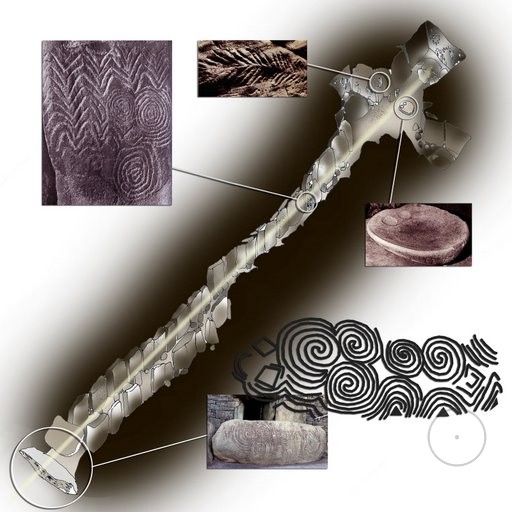
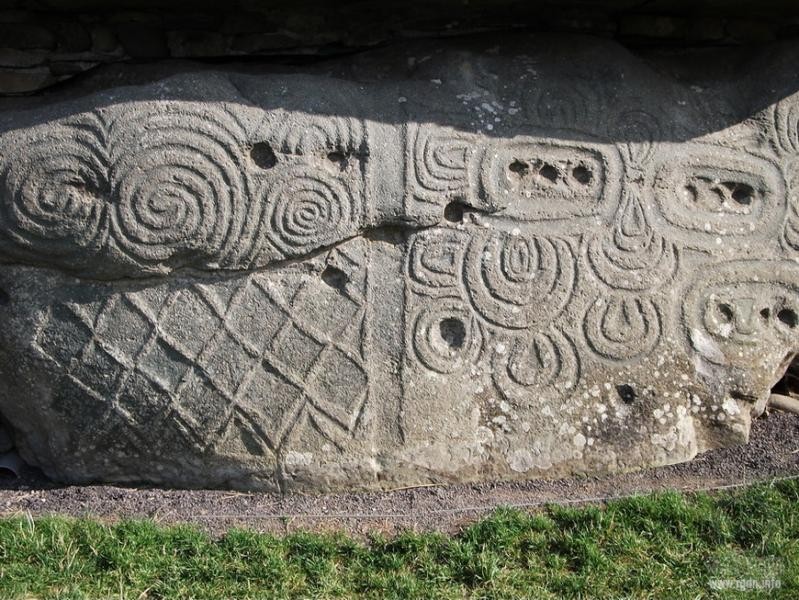
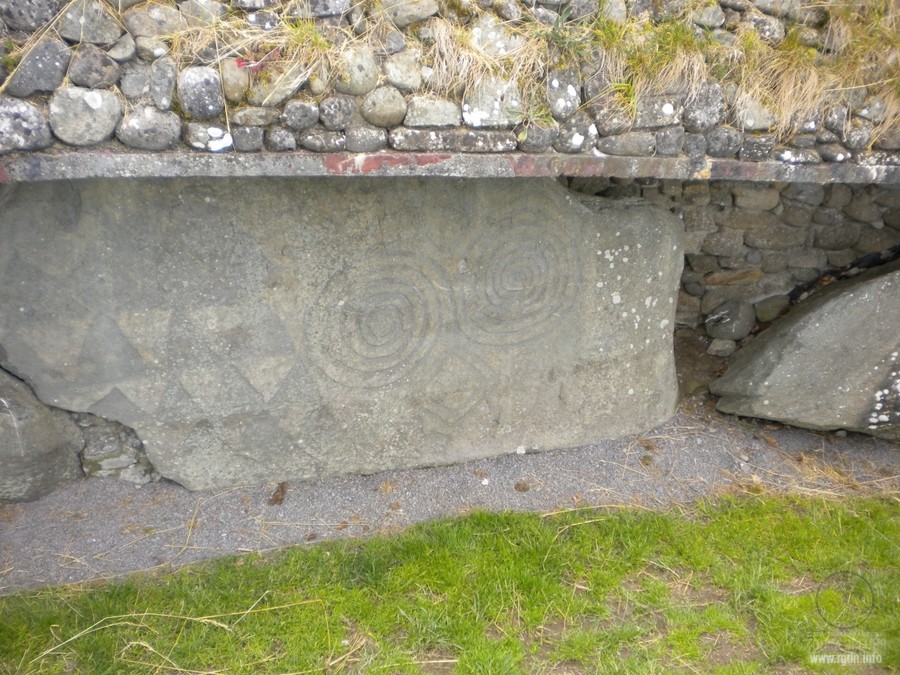
Spirals represent a principal element of ornaments and patterns on the stones, in particular triskelions – triple spirals. At that, on the outside of the mound there are both right-sided and left-sided spirals, but inside the building all the carved spirals are twisted clockwise.
The AllatRa book, pages 41-42, 365 – allatra.us:
Anastasia: Spiral galaxies were among the first to be discovered. Does a spiral shape play any special role in the micro- and macrocosms of the Universe?
Rigden: Yes, it does, and it relates to the structured movement of energies, as well as to storage and exchange of information, generally speaking to in-depth physics. If you study this issue carefully, you will be able to understand that many things in the material world are arranged in a spiral shape or move along a spiral, starting from micro-objects and up to macro-objects.
***
Spirals in the sacred knowledge about the human being are, as a rule, conventional designations or directions of energy movement in the process of either a spiritual practice or the powers of Allat, if it is connected with information about the origin of the world. A spiral twisted clockwise meant positive, generative spiritual forces, while a counter-clockwise spiral referred to negative, destructive forces of the Animal Mind, which were opposing the powers of Allat. In the designation of spiritual practices, spiral symbols were used in the meaning of energies or of their fusion. Moreover, a spiral of three and a half turns designated the energy which in the East, as I have already mentioned, is still being called “the sleeping Kundalini serpent” and symbolises the hidden energy potential of a human being.
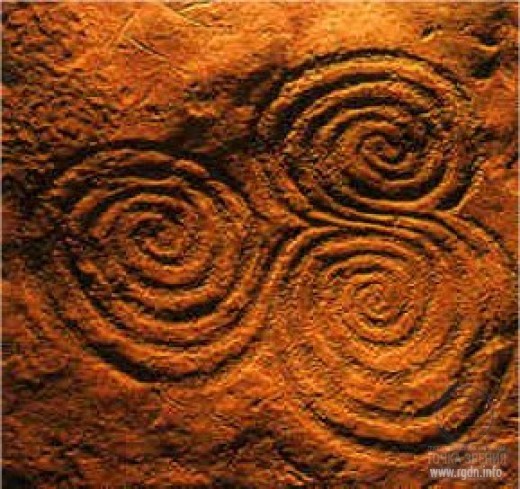
The purpose of Newgrange is still disputable. As it has been mentioned above, the favourite hypothesis of contemporary science regarding the purpose of megalithic structures has also been attributed to Newgrange which is still called a sepulchre. Dead human bodies were supposedly burnt there, while remains were left inside the sepulchre. As for the light penetrating through the window, it is a symbol of regeneration. Many researchers (e.g. Martin Brennan, Erich von Däniken) called such theory in question, since there are no relevant proofs. Furthermore, there are assumptions that sacrifices were offered to gods in Newgrange main premise, but this has not been proved either.
Those people who are one way or another engaged in self-development not only as of a material body, and who examine various energy processes, call such structures as Newgrange and Knowth dolmens where enlightened representatives of the earlier human races left for eternal meditation, “having deliberately preserved themselves”. The purpose of such action was to keep the knowledge accumulated by humanity and transmit it to future generations. In places where dolmens are located various extraordinary phenomena often take place. For instance, even ancient texts indicate that strange huge luminous spheres were detected in Newgrange area.
Ezoosmos by Anastasia Novykh:
“It’s a mystery. Processing of some ancient dolmens is dated to the Stone Age when only hunters and gatherers lived, as our official history asserts. Although…” Nikolai Andreevich smiled, “as the saying goes, nobody changes history as much as historians do. Yet, the paradox of dolmens and other megalithic structures is that the older such complex is the larger and heavier it is. That is, the extreme antiquity is characterized by gigantic, thoroughly considered and designed structures, moreover having astronomical and geometrical knowledge embodied in them. What does this indicate? It indicates that in olden times people did possess serious knowledge.”
“How many people should be involved to construct such a bulky object?”
“The most interesting thing is that there were much less people on the Earth before than there are nowadays. Besides, they were widely spread around the globe. Those were not our current billions.”
“Why did they really need to construct the dolmens?”
Nikolai Andreevich shrugged his shoulders.
“These structures are considered to be “warrior burial places”, although most of the dolmens are empty. There are no traces of mortal human remains at all. Above all, such dolmens are scattered all over the world, on all the continents. In prehistoric regions of Europe only, there are more than a thousand of such structures of approximately the same architecture. Scientists have even estimated by the measurement of such stone monoliths that in Europe of the ancient times there was a single generally accepted measure of length – the megalithic yard. It equalled to 82.9 centimetres. Hence, we may easily assume that those who were building such structures were quite skilled in mathematics as well. Furthermore, it is not clear how they were installing all this.”
***
“Did other dolmens have a similar purpose?” Nikolai Andreevich asked.
“It depended,” Sensei shrugged his shoulders. “Some of them were creations of Geliars and Etimons. Moreover, these dolmens were used as power traps.”
“In which sense?” Sergey asked.
“I will tell some other time… Later on people began to imitate them, constructing already smaller dolmens.”
“So, are the Pravi’s remains lying in this one?” Father John asked again to make it clear.
“There are no remains here in reality.”
“What do you mean? You have just said he was buried here.”
“Here he died in our understanding, whereas in actual fact he left for Nirvana, having destroyed his body into atomic and subatomic particles first. So, you won’t find even his ashes here.”
The aforesaid article by E. Vorontsova referred to the correlation between Newgrange and the Egyptian pyramids. There is another interesting fact, too: the angular distance between the centre of the mound in Ireland and the summit of the Great Pyramid of Giza equals exactly to 36 degrees, or 1/10 of the girth of the Earth, which can easily be verified via Google Earth.
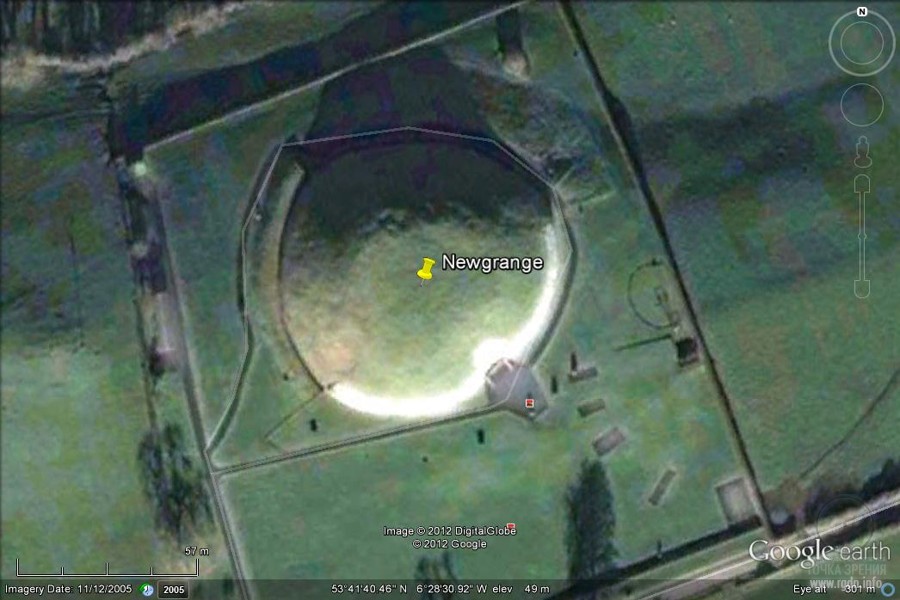
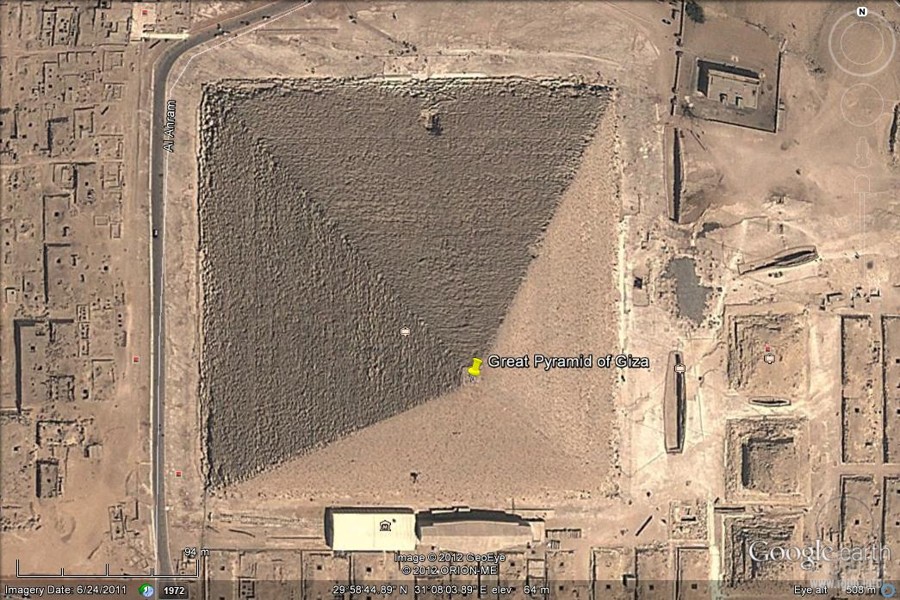
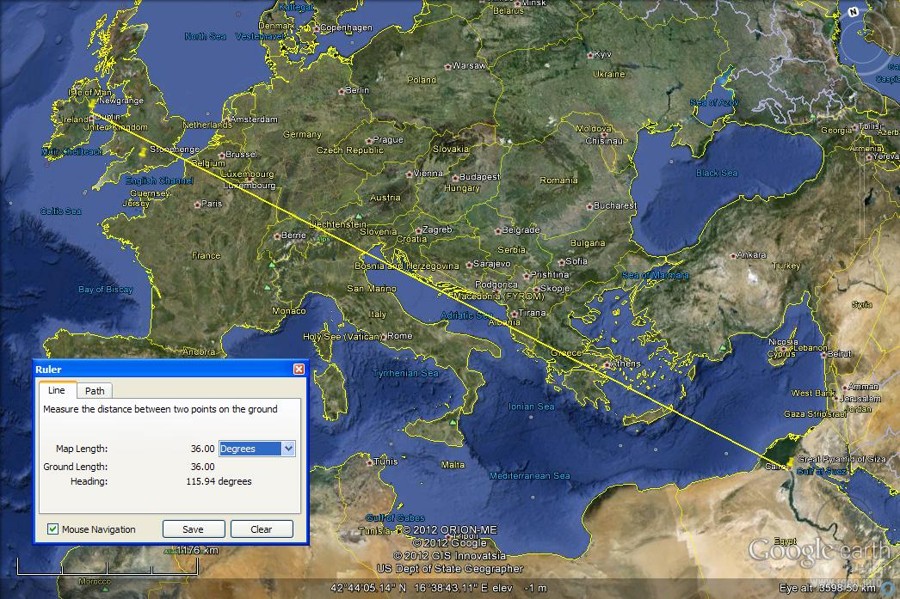
36 degrees are a very significant number. It is a half of 72, while 72 is the number of years during which the spring equinox point is shifting by one degree along the Zodiac (72 * 360 = 25920, the full precession cycle). In his Heaven’s Mirror: Quest for the Lost Civilization Graham Hancock states the geodetically enormous temples of Angkor Wat in Cambodia are separated from the Pyramids of Giza in Egypt by 72 degrees longitude. (This was mentioned in the article http://rgdn.info/en/angkor_i_giza._drakon_i_orion._apokalipsis_segodnya)
In view of the Primordial Knowledge, 72 is the number of dimensions in the global Universe.
These 72 dimensions are generally represented by subtle and crude energies that constitute certain energy fields forming a particular dimension. There are no clear boundaries between them. Same energies may be present in one dimension, and in another, and in a third one. All the dimensions are interconnected and separated at the same time. (the AllatRa book, page 175 – allatra.us)
There is no doubt such coincidences are far from being accidental, and Brú na Bóinne mound complex, just like other ancient structures, is oriented according to the sky map and ley lines.
Even when the monument was in ruins, there were numerous beliefs and legends about it. Thus, there are Celtic myths where Newgrange is called the Mound of Fairies. The mound was also regarded as the home of god Dagda (Dagda is the “kind god”, “father of everything”, “lord of heavens”, “god of knowledge”) and his wife Boann. Moreover, there is a romantic story telling that Dagda’s son Aengus (the god of love) lived in Newgrange with his beloved Caer, and they lived there as swans.
Perhaps, the swan image appeared in the myth not by chance. In his book The Newgrange Sirius Mystery: Linking Passage Grave Cosmology with Dogon Symbology, released in 2013, James Swagger states the cruciform chamber has a shape of a cross, while the cross symbolizes the constellation of Cygnus.
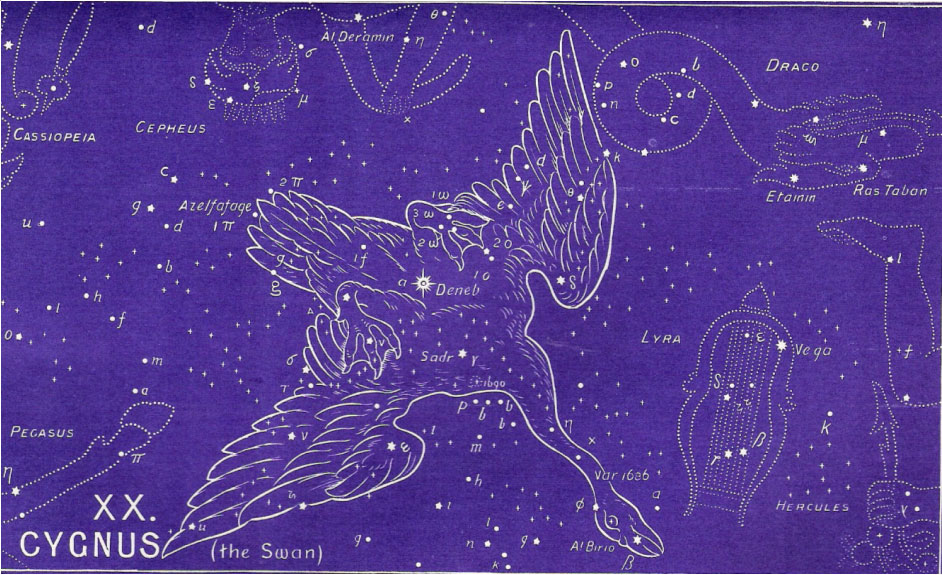
Furthermore, the author thinks such shape of the premise produces a special acoustic effect which helps one to plunge into an altered state of consciousness.
The book also contains an opinion that triple spirals carved on outer stones and inside the chamber symbolize stations of the triple star Sirius. The spiral inside the chamber serves as a marker of the event when on the winter solstice Sirius “enters” the premise similarly to the Sun, though 12 hours later than the “light miracle” takes place. This is what I grasped from Swagger’s interview. Unfortunately, I failed to find the book in Russian (most probably, no translation is available yet) in order to familiarize myself with relevant information in detail.
Recurring to Celtic mythology, one of its most important attributes is Dagda’s Cauldron. It was a symbol of abundance, and countless people could be fed from it. The naïve myth ceases to seem a tale for children, when at the sacred site you see the oval stone bowl of gigantic dimensions, which I have mentioned above. At that, if we assume Newgrange was a “power trap”, in such case could our wise predecessors somehow use the bowl to transform radiation of the celestial body and apply the obtained energy for their spiritual development?
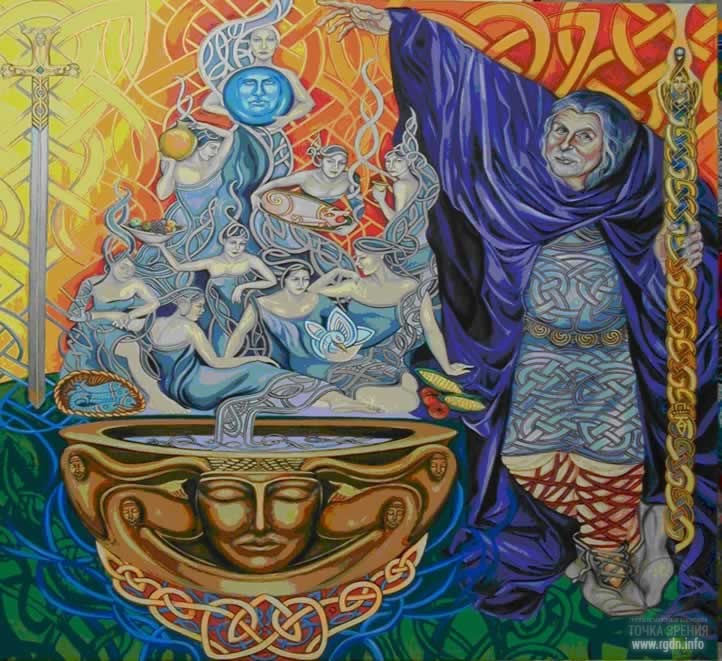
A similar bowl was discovered in the inner premise of the Knowth mound. Moreover, there is a sign carved on it, which resembles the AllatRa sign very much.
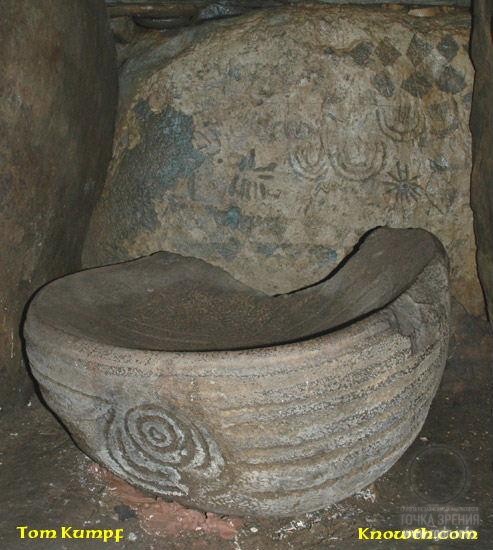
By their shape and size the bowls are similar to the stone “pools” discovered in Egypt and mentioned in Episode 1 of The Pyramid Code documentary.
There are also many interesting Irish records and tales of the Land of Eternal Youth, where mounds represented “entrances”, a sort of “stations of departure”. Sids (Irish mythology: the people of wizards, sages and poets, perfect in arts and magic, usually living under the ground) let some people stay with them for a while. People got into a big castle on the island that “stands… on feet of white bronze”. It seemed to them they had stayed for just a year in the castle, and when it was time for them to return home, after long persuasion Sids gave such permission. However, it turned out that in the magic world time flew more slowly than on the earth: years at the Sid castle ran as centuries on the earth.
Furthermore, we may assume that millennia ago a space launching site was located in the BoyneValley, and flights to other planets were carried out from there.
Sensei of Shambala – Book IV by Anastasia Novykh:
Besides the Baalbek Veranda, there were other cosmodromes which didn’t require such a big takeoff-and-landing site. There was a region at the very base of the Nile ‘flower’ for such spaceships. Naturally, such intensive traffic was noticed by people. That is why quite interesting ancient legends about that time were preserved in the memory of generations.
Moreover, the Irish tale reminded me of the legend of Shambala which is now located at Belovodye. Here you can familiarize yourselves with the legend: https://www.youtube.com/watch?v=7NeGtkZOQ4o, and below there is the legend fragment:
Many people from everywhere seek the CherishedLand, but in every hundred years only seven invited ones get there. Six of those return with secret knowledge, the development of new feelings, the radiance of the soul and heart, like myself, and only one remains there. Those who reside there live for as long as they like and need. Time stands still for them.
In his book Evidence of the Gods Erich von Däniken calls Newgrange “the true masterpiece of geodesy, astronomy, and transport”.
Only one thing may be said with certainty: somebody in the remote antiquity made the most accurate astronomical clock – the monument that communicates its message with invariable precision for 5 thousand (or more?) years. Which message? Who were the sages, the initiates who managed to leave such a trace in history for their descendants? What did they need this for? What urged them to do so? What were those people like?
It seems like The Crossroads book by A. Novykh contains an answer to one of the above questions:
The Celts, or Gauls as the Romans called them, mentioned our lands in an interesting way. They were real Sages, true Sokrovenniks! For a very long time they closely cooperated with Shambala. By the way, ancient Druids called Rigden Djappo in their own way, too – mostly Dagda (the Kind Deity), or Ruaidh Rofhessa which is translated as “the Red of the Perfect Science”. The outcome of such cooperation was obvious: in their time Druids created almost an ideal society. Later on, there certainly appeared “newcomers” who defiled the Druid teaching as well, having turned the Truth into Falsehood. But the first Druids were indeed remarkable personalities.
The most interesting thing is that ancient Druids basically wrote nothing, despite the fact they had a perfect knowledge of written language, astronomy, astrology, mathematics, and even physics, although they called physics differently and applied it for studying the human nature and essence.
Dagda image on the Celtic silver Gundestrup cauldron
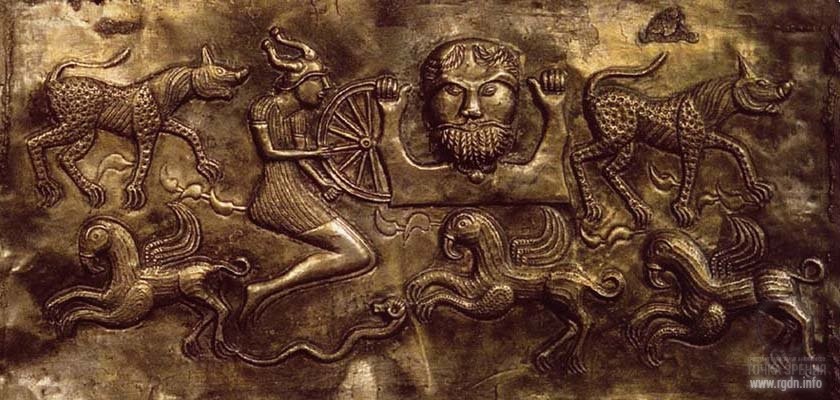
While studying materials on the Irish mounds I have come to realize that, if in ancient times people were able to communicate with representatives of the higher world easily, possessed advanced Knowledge of the world of not only coarse matter but subtle energies as well, and skilfully used the Knowledge, all this is quite possible for us, too. After all, in olden times a human being had exactly the same structure as nowadays, and the human structure makes it possible to achieve a lot. It is so wonderful that we have somebody to align ourselves with and something to strive for! And it is such happiness that we have a solid foundation for creating a new type of society and returning to our sources, and such foundation is the Knowledge once again brought to the world by Rigden Djappo!
Prepared by Alina (Mullingar, Ireland)
 Newgrange: the heritage of Druids
votes:
206
Newgrange: the heritage of Druids
votes:
206
|

Project Aim










Leave comment